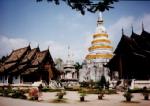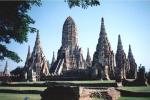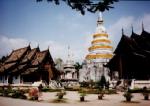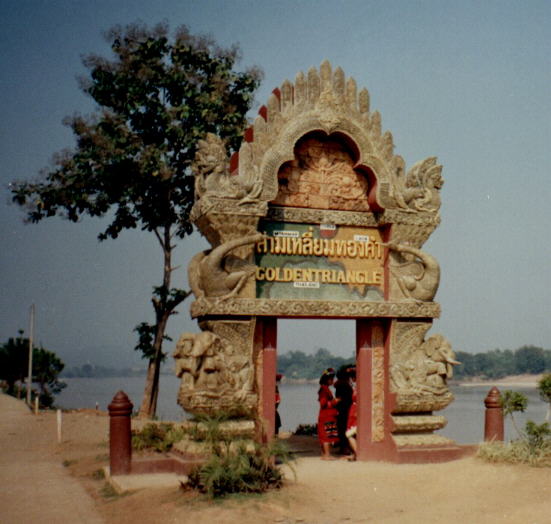

 Bangkok:
Bangkok:

Escaping the confines of Bangkok I headed North via the ancient capitals of Ayutthaya, Lopburi and Sukhothai to Chiang Mai - the second city of Thailand and as distinct from Bangkok as Edinburgh or Glasgow from London.
Sacked, looted and razed by Burmese invaders the historic ruins of the ancient kingdom of Ayutthaya are confined in the confluence of the Pa Sak River and the Chao Phraya River some 85Km to the North of Bangkok.
In a cavalcade of motorbikes I was conducted by Thai friends on an all-day, circular tour of the widely scattered monuments. From the top terrace of Phra Khao Thong ( Golden Mount Chedi ) we surveyed the flat countryside dotted everywhere with tall chedi. A line of three, giant chedis , typical of the Ayutthaya-style, dominated the widespread ruins of the old Royal Temple of Wat Phra Sri Sanphet - sad but impressive relics of the once illustrious city.
|
Chedi at Ayutthaya |
Sanuk - the Thai philosophy of enjoying life - prevailed that evening:- five-a-side football, dinner at a Vietnamese restaurant, drinks in a late-night bar with a Thai pop group.
From
Ayutthaya  the country road
to Lopburi meanders through the extensive rice paddies and
waterways of central Thailand
with
views of traditional, wooden, farm buildings and occasional wats
.
the country road
to Lopburi meanders through the extensive rice paddies and
waterways of central Thailand
with
views of traditional, wooden, farm buildings and occasional wats
.
On a grassy mound near the centre of the old city the archetypal monument of the 12th century Angkor empire of the Khmers is Phra Prang Sam Yot with its three, massive prangs symbolizing the three Hindu gods of Shiva, Vishnu and Brahmin - another testimony to ancient invasions repelled by the Thais to maintain their fierce independence - the only country in the region not to have been colonized by a European power. However the proud relic seems totally incongruous in its present day surroundings of busy roads and railway lines.
|
Phra Prang Sam Yot in Lopburi |
Continuing through Nakon Sawan, with its predominately Chinese-Thai population, to the pleasant, riverside, town of Tak I made a day-trip to explore the extensive ruins at Sukhothai - Thailand's most important historical site where the first Thai capital was founded in the 13th century.
The ancient Sukhothai ( 'rising of happiness' ) Kingdom is considered to be the Golden Age of Thai civilization with the most classic of Thai styles. In a picturesque setting of manicured lawns and lotus-filled ponds and moats there are 198 chedis and many stately Buddha figures amongst the temple ruins of the old city.
|
Sunset on Ping River at Tak |
In Tak that evening, out for a stroll along the banks of the Ping River, I had another unpleasant encounter with local dogs - another major hazard of Thailand - an estimated 50% being infected with rabies - they seem to have a particular animosity towards farangs.

Leaving the plains of central Thailand the road from Tak winds through scenic, forested hills on route via the small, provincial capitals of Lampang and Lamphun to Chiang Mai - the second city of Thailand and popularly known as "The Rose of the North".
Situated on the banks of the Ping River many of the city's 300 temples are confined within a neat square bounded by moats and the partially-restored remains of the old battlements. As in the other ancient capitals the wats are the main feature of interest but in Chiang Mai there is a greater architectural variety with northern styles blended with Burmese influences. The wats are also the the focus of Thai cultural life - most young men spend at least two years of their lifes training as monks. In rapidly developing Thailand construction applies not only to roads, buildings and factories but also to new wats and renovation of old ones.
|
Wat
Phra Singh in Chiang Mai
|
Based in Roong Ruang hotel near Thae Phae Gate, one of four breaches in the fortifications, I was conveniently situated both for the street markets and bazaars of the local Chinatown and the complementary Night Market - the most extensive in Thailand. Both markets can provide incredible bargains - eg silk shirts for £4 - provided you know how to haggle. However most of the designer-label goods are poor quality fakes.
Four hours on the new road from Chiang Mai brought me to Chiang Rai, the quiet capital of the northernmost province of Thailand and the Gateway to the Golden Triangle - only short trips by local bus are required to reach the frontiers with Burma and Laos.
My first foray was to the hill village of Mae Salong at the end of a 36Km undulating, mountain road giving sweeping views over forested hilltops. My fellow passengers in the songthaew were from local hilltribes - Akha, Lisu, Mien, Hmong - the women wearing colourful, embroidered, traditional costume with chunky, silver jewellery but the young men in standard American gear - baseball caps, T-shirts, jeans.
Also living in the small, isolated villages of the region are many migrants from the southern province of Yunnam in nearby China.
While the steep hillsides are unsuitable for most crops they are ideal for opium. However with the introduction of a government crop substitution program of tea, coffee and fruit growing, together with rigorous law enforcement, the opium trade has been pushed across the borders into neighbouring Burma and Laos.
A second foray was to Mae Sai, the northernmost town in Thailand, where the bridge across the Sai River is one of only two official land crossings into Burma ( but restricted to Thai and Burmese nationals only ). Walking down the single main street there was a real frontier town atmosphere with Burmese men in their longyis mingling with Hmong and Akha women in their hill-tribe dress. The shops were full of Burmese goods:- lacquerware, gems, jade and carved teak.
From Wat Phra That Doi Wao on the hilltop above the town there was a fine outlook across the river to the Burmese village of Thachilek and the wooded hillsides beyond.
|
Mae Sai frontier with Myanmar / Burma |
Enjoying a cha yen ( iced tea ) on the terrace of a riverside restaurant I watched young Burmese diving in the river to bring up scoopfulls of gravel; boatloads were then punted across to the Thai side - raw material for the contruction boom taking place.
A final foray was to the small town of Chiang Saen on the banks of the mighty Maekong River where the concrete embankments on the Thai side contrasted with the undeveloped, muddy banks across the broad, swiftly-flowing waters in The People's Democratic Republic of Laos.
|
Maekong River frontier
with Laos at Chiang Saen
|
It was only a short distance upriver to the small cluster of tourist buildings at Sop Ruak - the official centre of the Golden Triangle at the confluence with the Sai River. Climbing to a temple on a hilltop above the rivers I gazed out into Burma and Laos. Unfortunately at present only locals can cross the borders. In future they may be opened to tourists and a loop through Burma, Southern China and Laos may then become possible.
 Golden
Triangle at
junction of Myanmar / Burma, Laos and Thailand |
In any event, for my present trip, I was running out of time ( and money ). Turning South I started on the long return journey to Bangkok and back to Scotland. The thought of leaving tropical Thailand was not appealing - one of the main reasons for coming to SE Asia had been to escape the vicissitudes of the Scottish winter - it was snowing on my arrival in Glasgow.